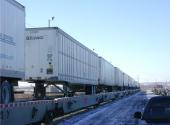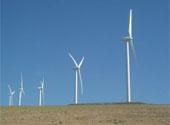The Steel Interstate delivers a cleaner, greener, lighter footprint on the landscape than commensurate highway construction and use. The Steel Interstate System would dramatically reduce America's contribution to climate change from our transportation sector. Trains fit into a development pattern that promotes sound land use policies and positive results for energy conservation, air and water quality, and livable communities for human beings, forests, and wildlife.
Railroads are already about four times more energy efficient in moving a ton-mile of freight than comparable over-the-highway truck movement. Electrification of the Steel Interstate boosts this existing advantage considerably. Electric locomotives accelerate and decelerate more rapidly, carry less redundant weight because there is no engine, can be more powerful than diesels and hence replace them on a less than one for one basis. A big efficiency gain comes from the Steel Interstate using power generated in power plants, where efficiency is typically 65% or more, rather than on each individual diesel locomotive, where energy efficiency may fall in the 35 - 40% range. And of course using centrally produced power opens the door to many kinds of renewables that today cannot be used in transportation.
Less fuel consumed to produce a ton-mile of transportation means less pollution created, less greenhouse gases, lower impact on climate change and the environment.










